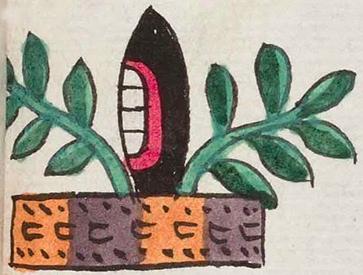Tzinhuitzquilocan (Mdz30r)
This compound glyph for the place name Tzinhuitzlocan has three notable elements. At the center is an obsidian blade (itztli), which shares its name with a deity, possibly explaining the embedded mouth. It is vertical, pointed, primarily black, and on the side facing left is a red-gummed mouth with four white teeth. On each side of this blade is a stalk or sprig of (huitzquilitl), an edible and medicinal herb, and each stalk has six leaves painted a two-tone green. Below the blade and herbs is a horizontal rectangular representation of an agricultural parcel or parcels, textured with dots and c's and segmented into two purple and two orange alternating subdivisions.
Stephanie Wood
The representation of land at the base of the glyph does not appear to play a role in the phonetic reading of the place name, which could be -tlal-, -mil-, -chinam-, or -ixtlahua-. It might be a semantic complement that provides some sense of the place (the "where" of the -can locative suffix).
The Tzin- and -hui[tz?]- syllables at the beginning of the place name (and as supported by the gloss) are not adequately represented by the visuals. The line over the i in Tzi, seems indicate Tzin-, and the itztli may suggest we add the -tz- after the -hui-, therefore Tzinhuitzquilocan. The contemporary spelling of the place name leaves out the "qui" syllable that may have once been important (especially if quilitl or huitzquilitl is key to the place name).
Very similar to the herbs that appear here are the edible, medicinal herbs called huitzquilitl, such as those that appear in the compound glyph for the place name Huitzquilocan. See below, right, for examples of the huitzquilitl along with the more generic quilitl (called quelites in Mexican Spanish today).
The syllable -o- here is read by Frances Karttunen as the -yoh that means "invested with the quality of." This could mean that this place is known for having lots of whatever herb (quilitl) or huitzquilitl) this compound glyph is meant to indicate.
Various sources, such as Charles Gibson and Hubert Howe Bancroft, provide the spelling that is used in this collection for this particular town name. According to Pedro Carrasco (Estructura político-territorial del imperio tenochca, 2016) Tzihuinquilocan was a pueblo founded by Nezahualcoyotl. He says that today the town name is spelled Singuilucan, and it is in the state of Hidalgo.
Stephanie Wood
çtzīhuinquilocā. puo
Tzinhuiquilocan, pueblo
Stephanie Wood
c. 1541, but by 1553 at the latest
Stephanie Wood
While three visuals are prominent in this compound, the phonetic components are not a solid match.
herbs, hierbas, plantas medicinales, tierras, espinas, puyas, nombres de lugares

huitzquil(itl), an edible, medicinal herb, https://nahuatl.wired-humanities.org/content/huitzquilitl
-yoh-, invested with the quality of, https://nahuatl.wired-humanities.org/content/yoh-0
itz(tli), an obsidian blade or knife, https://nahuatl.wired-humanities.org/content/itztli
huitz(tli), a thorn or spine, https://nahuatl.wired-humanities.org/content/huitztli
quili(tl), edible herbs or vegetables, https://nahuatl.wired-humanities.org/content/quilitl
-can (locative suffix), where, https://nahuatl.wired-humanities.org/content/can-2
"Place Full of Itzihuinquilitl" (Berdan and Anawalt, 1992, vol. 1, p. )
Codex Mendoza, folio 30 recto, https://digital.bodleian.ox.ac.uk/objects/2fea788e-2aa2-4f08-b6d9-648c00..., image 70 of 188.
The Bodleian Libraries, University of Oxford, hold the original manuscript, the MS. Arch. Selden. A. 1. This image is published here under the UK Creative Commons, “Attribution-NonCommercial-ShareAlike 3.0 License” (CC-BY-NC-SA 3.0).




